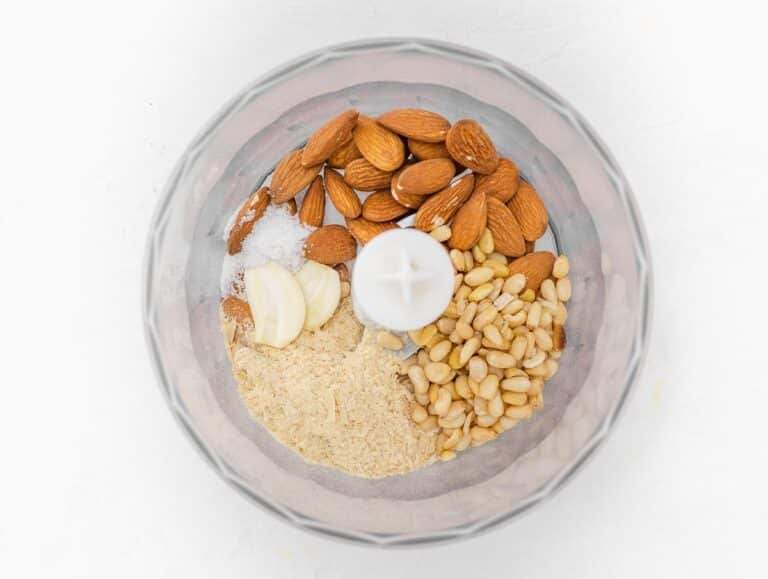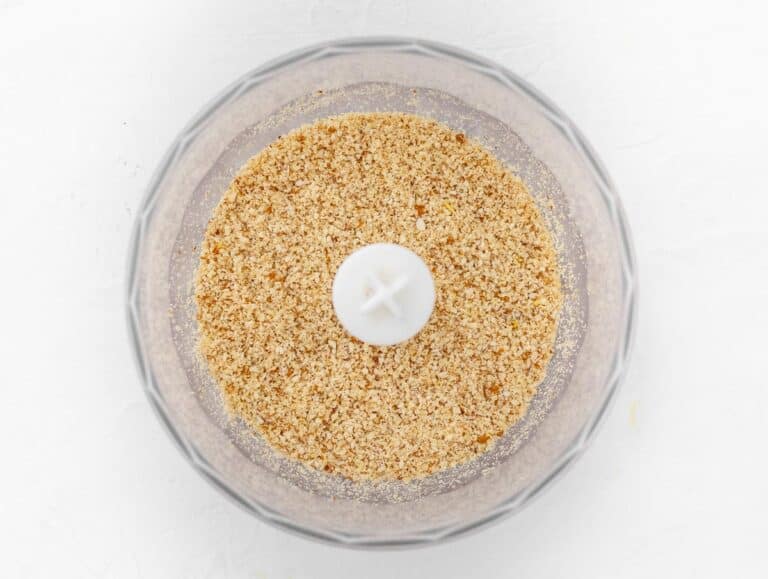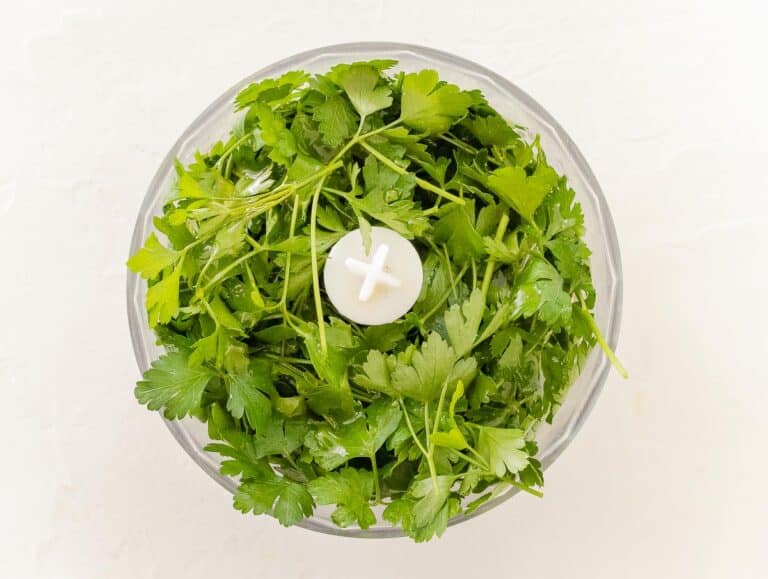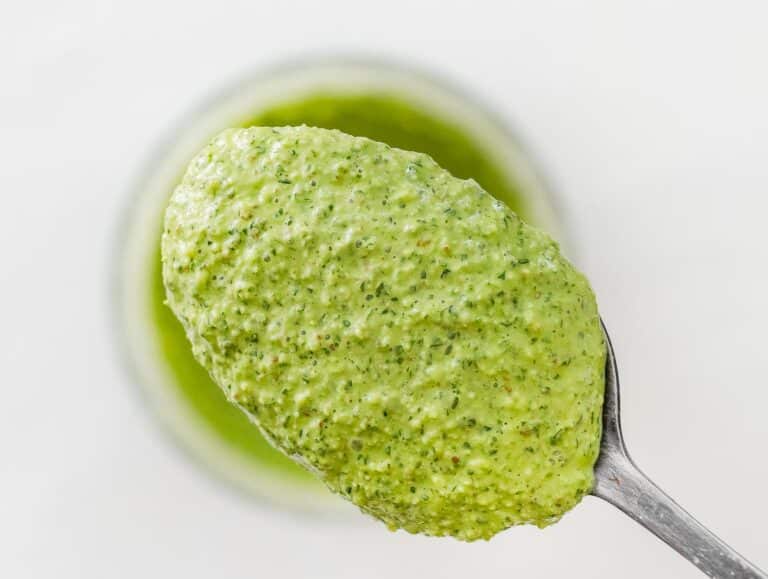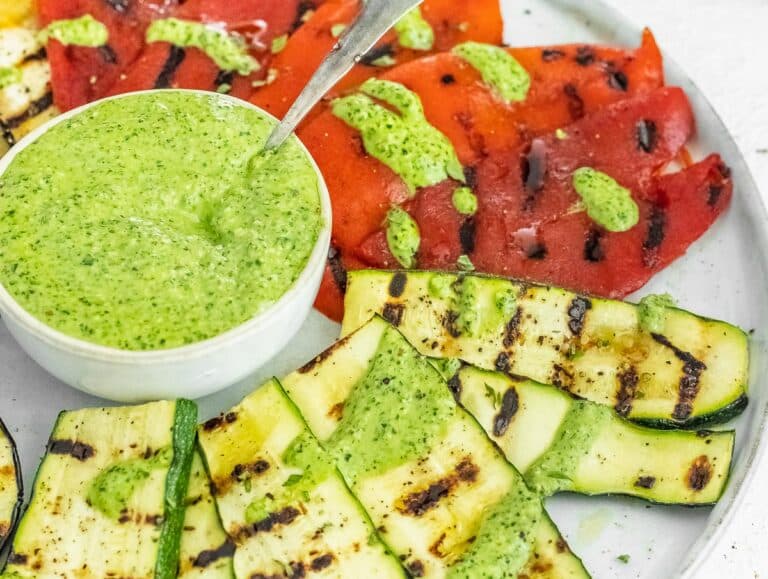Parsley Pesto is a simple recipe that’s made in 5 minutes in a food processor. It’s so fast and easy to make, and it tastes really delicious on almost anything!
It’s bright green, herby, light, and packed with flavor and nutrition. Also, we keep this recipe vegan so that anyone can enjoy it.
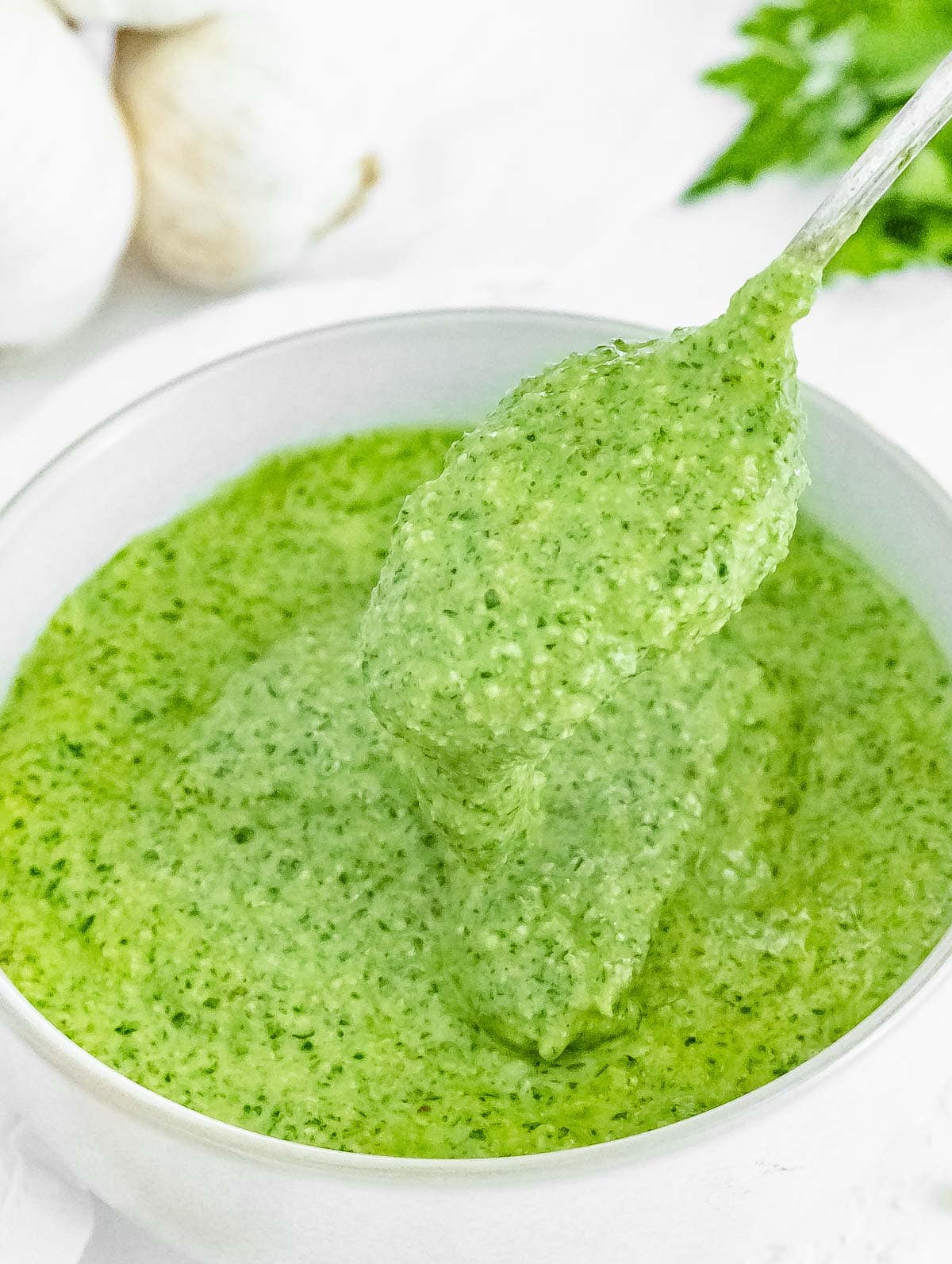
To learn more on this topic, check out our guide on how to make vegan pesto + 9 pesto recipes.
If you follow our blog you know by now that we are huge pesto fans. The thing is, once you learn the basics of pesto, you can easily customize the recipe based on the season, the veggies, and the herbs you have at hand.
In this case, for instance, the parsley plants we have on our terrace are growing like crazy and we literally can’t consume the parsley fast enough. And so we decided to make pesto with it.
Parsley pesto is awesome because you can make a huge batch of it in literally 5 minutes, freeze it, and use it at any time, within 6 months. And the best thing is that this parsley pesto recipe goes pretty much on anything.
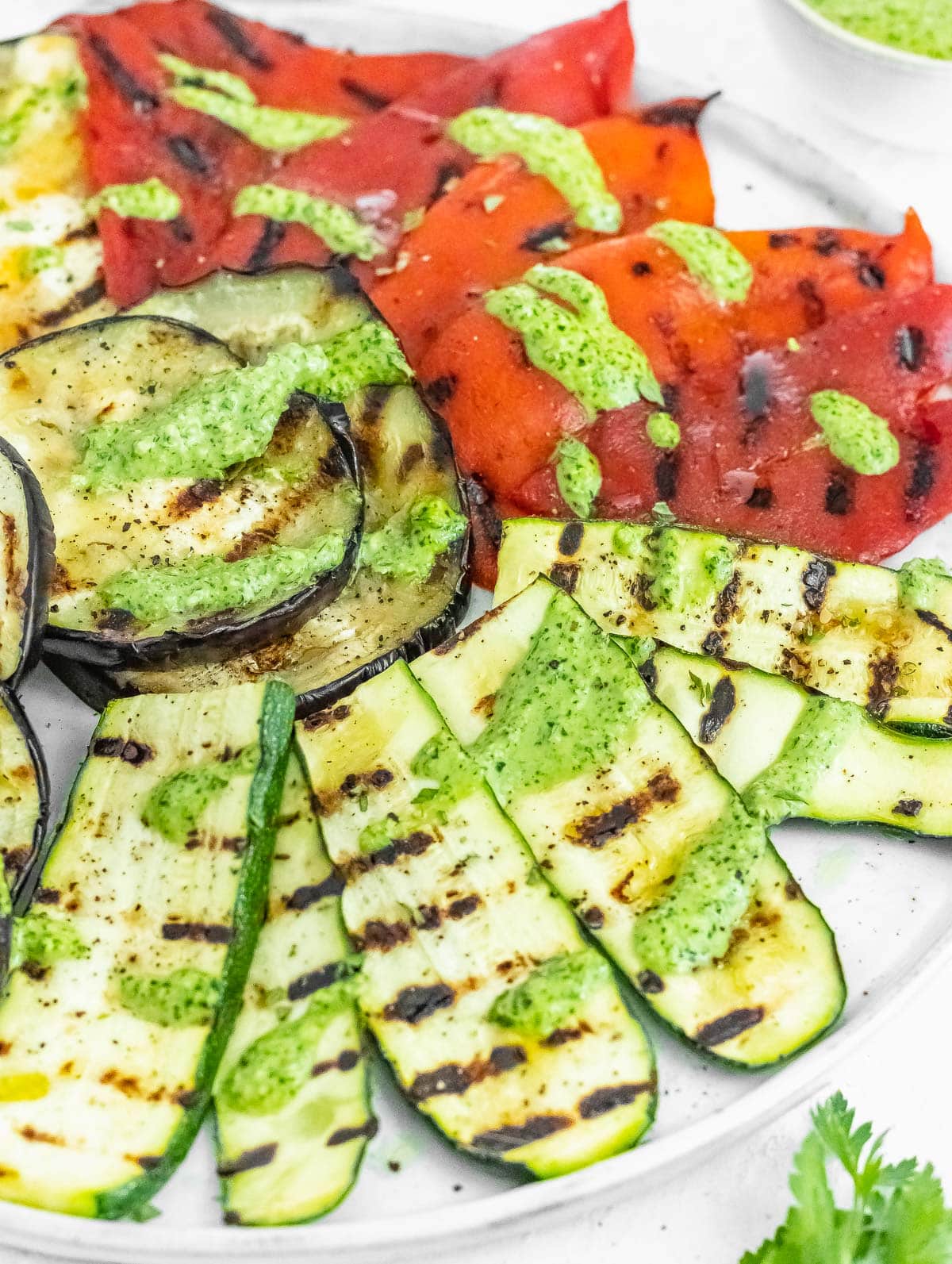
We tried it with homemade gnocchi, homemade pasta, regular pasta, pasta salads, on toasted bread, to dip focaccia, and even drizzled on things like tomatoes and grilled veggies, with a squeeze of lemon and a twist of black pepper. It’s just awesome, and we absolutely love it.
We like to make it with a medium thickness that is good for spreading on a slice of toasted bread or to use in a wrap or sandwich. If you want it thinner, for instance, to drizzle on something or to use as salad dressing, then just add a little more oil or water.
From this recipe, you can expect a pesto that is fresh, bright, healthy, nutritious, packed with plant-based protein and healthy fats, and vegan. We use nuts to replace the parmesan cheese and keep this parsley pesto dairy-free so that anyone can enjoy it.
Ingredients
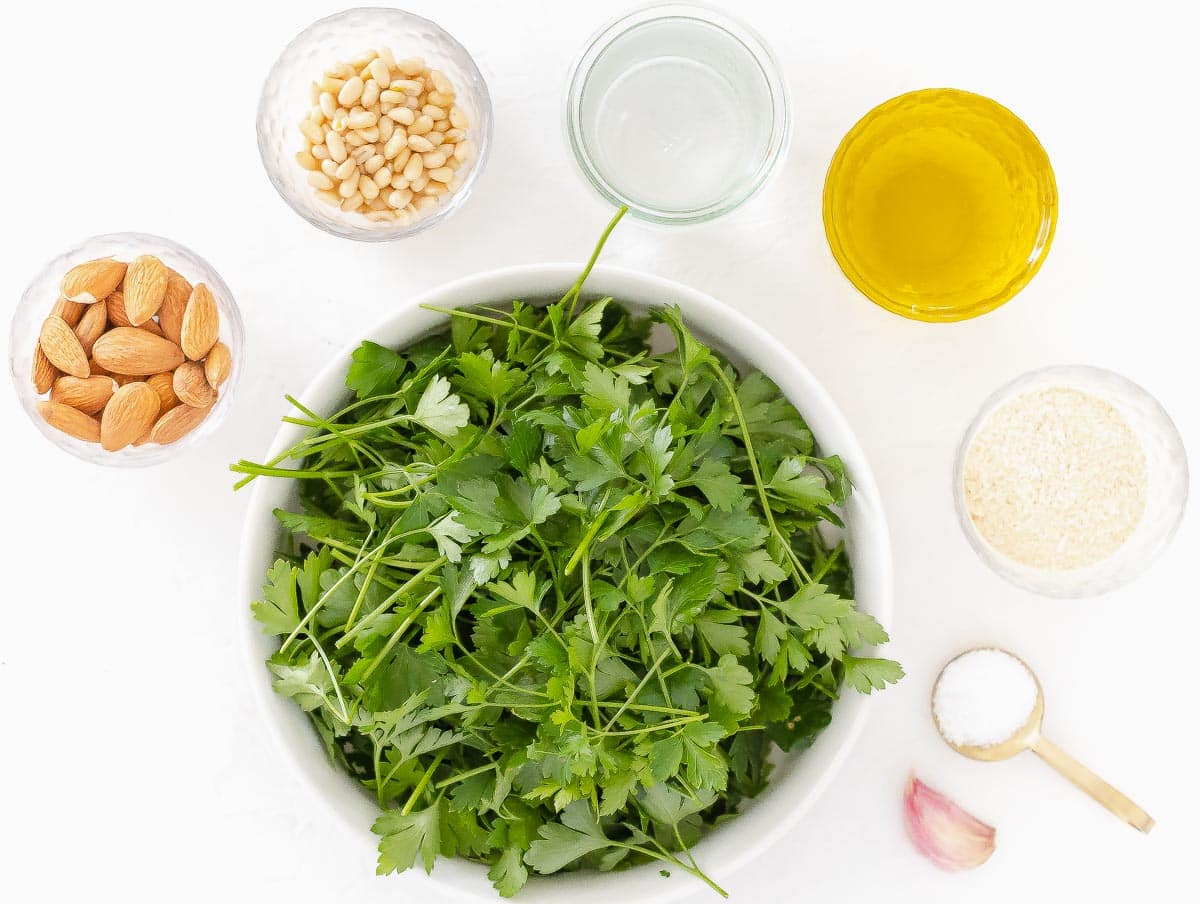
Parsley: we recommend using flat-leaf parsley, the Italian kind. Italian parsley is more tender and aromatic and more suitable to use for pesto. Its flavor is bold but not overpowering. Combined with the olive oil and the nuts it makes a bright and fresh pesto.
Curly parsley, on the other hand, is rougher, less aromatic, and less flavorful overall. It stays coarser in the pesto, it’s not as pleasant, and the pesto just doesn’t have the same depth of flavor. We find that pesto made with curly parsley requires another herb to taste good. You can use for instance half fresh basil leaves and half curly parsley.
Nuts: almond or walnuts are best for parsley pesto, and you can use them interchangeably. We use nuts to replace the texture, nutrition, and creaminess of the parmesan cheese. Nuts, of course, are way healthier than cheese, while still packed with protein and healthy fats. Other nuts you can use are pistachios, cashews, and macadamia.
Pine nuts: we list pine nuts separately from other nuts because they serve a different purpose, and behave differently. Pine nuts have a distinctive taste that makes any pesto more authentic. Also, pine nuts “melt” when blended, adding texture and creaminess that other nuts don’t. If you can’t get your hands on pine nuts, add more of the other nuts.
Garlic: a key ingredient in pesto. We use a small clove, but you can use as many garlic cloves as you wish.
Nutritional Yeast: This is an optional ingredient, but we do recommend it if you like a mild cheesy flavor in your pesto. We think that nutritional yeast really shines in this recipe, and makes it more flavorful and delicious.
Olive oil: extra virgin olive oil is recommended as it has a rounder, fruitier, and more aromatic flavor. It’s also healthier than regular olive oil because it’s mechanically pressed (not chemically), and it retains more antioxidants. If you don’t have extra virgin olive oil you can use regular olive oil.
Ice cold water: we add ice cold water to keep things cool in the blender, and the pesto extra bright in color. We also use water to reduce the amount of oil, which in traditional pesto is a lot.
Salt: since we don’t add any salty cheese like parmesan or pecorino, this parsley pesto recipe requires salt to taste good. We use 1/2 teaspoon, but you can adjust the amount of salt based on your taste and dietary preferences or requirements.
Other ingredients
Lemon: we don’t use lemon in our recipe, however, if you want to add lemon juice or lemon zest we recommend doing it just before serving the pesto. We don’t recommend adding lemon to the actual pesto because lemon doesn’t store well, and tastes best when fresh.
Also, authentic Italian pesto should not be acidic. There’s no lemon or vinegar in the original pesto recipe. The acidic flavor you taste in store-bought pestos is due to preservatives that extend shelf life.
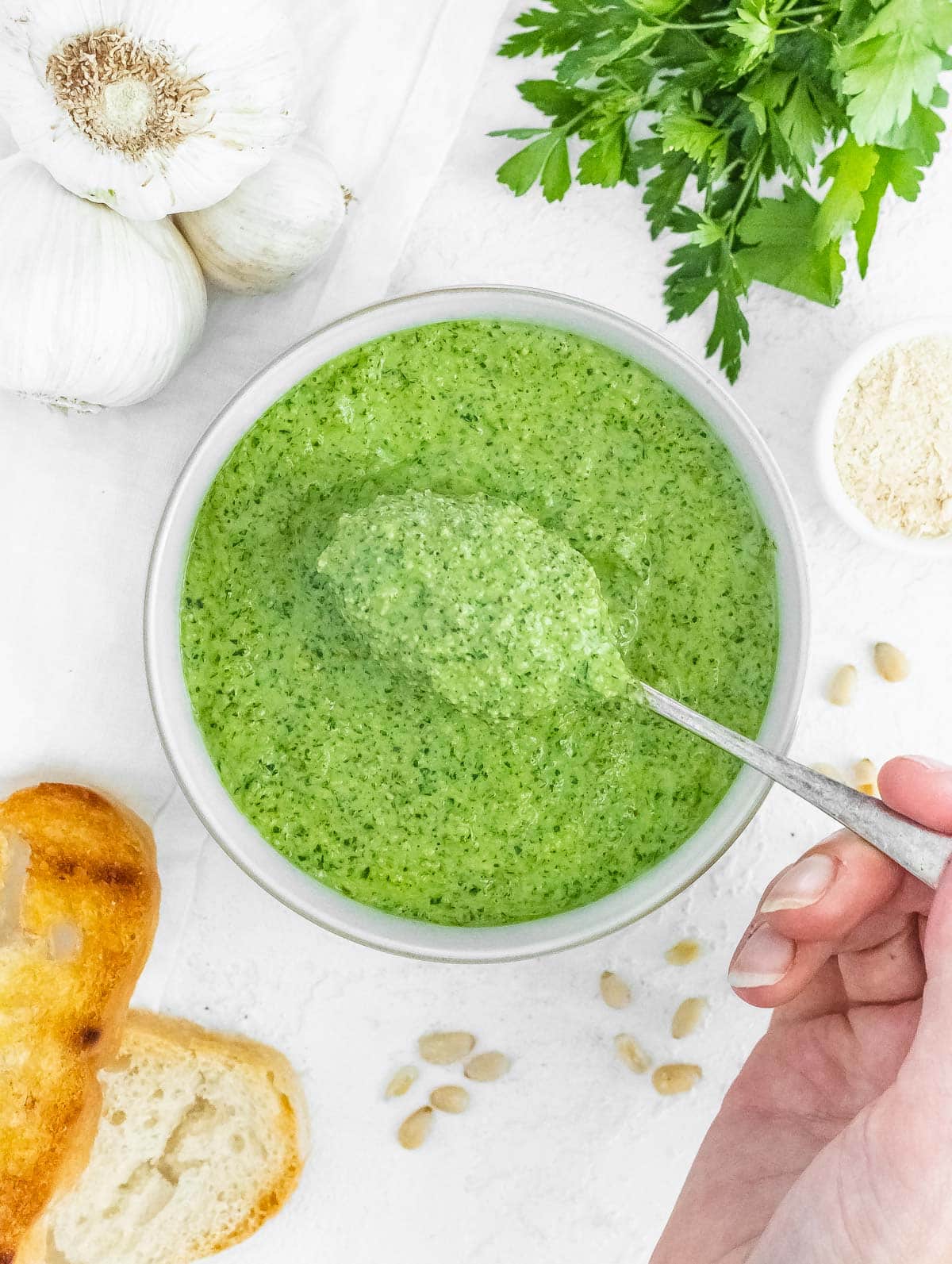
Instructions
Traditional pesto is made in a mortar with a pestle, but here we are making a quick version you can make in a food processor or blender.
The first step is to peel the garlic and cut it in half lengthwise. Remove the core of the garlic if there’s any. We find that part hard to digest, so we prefer to remove it.
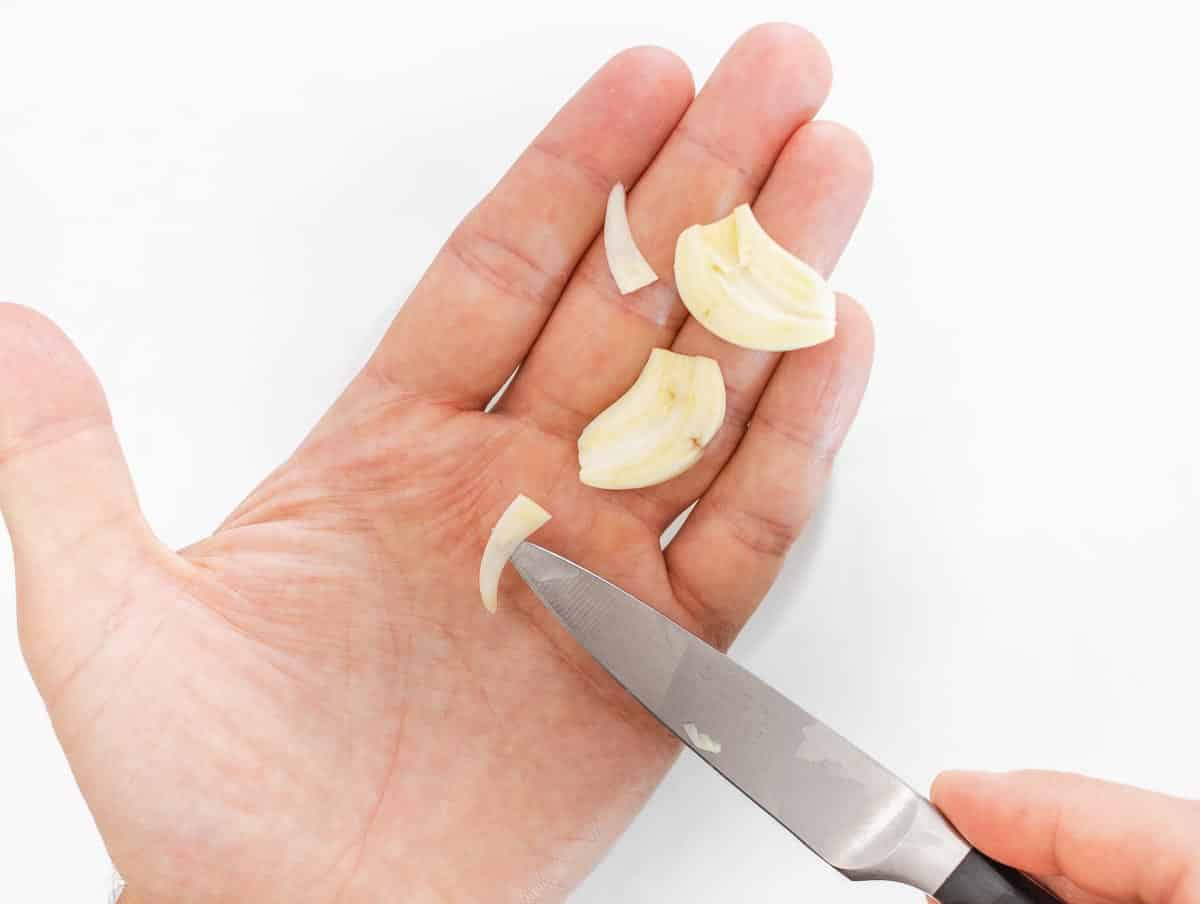
Add garlic, almonds (or walnuts), pine nuts, nutritional yeast, and salt to the bowl of a food processor. We use a small one here, it’s actually an immersion blender with a small food processor attachment.
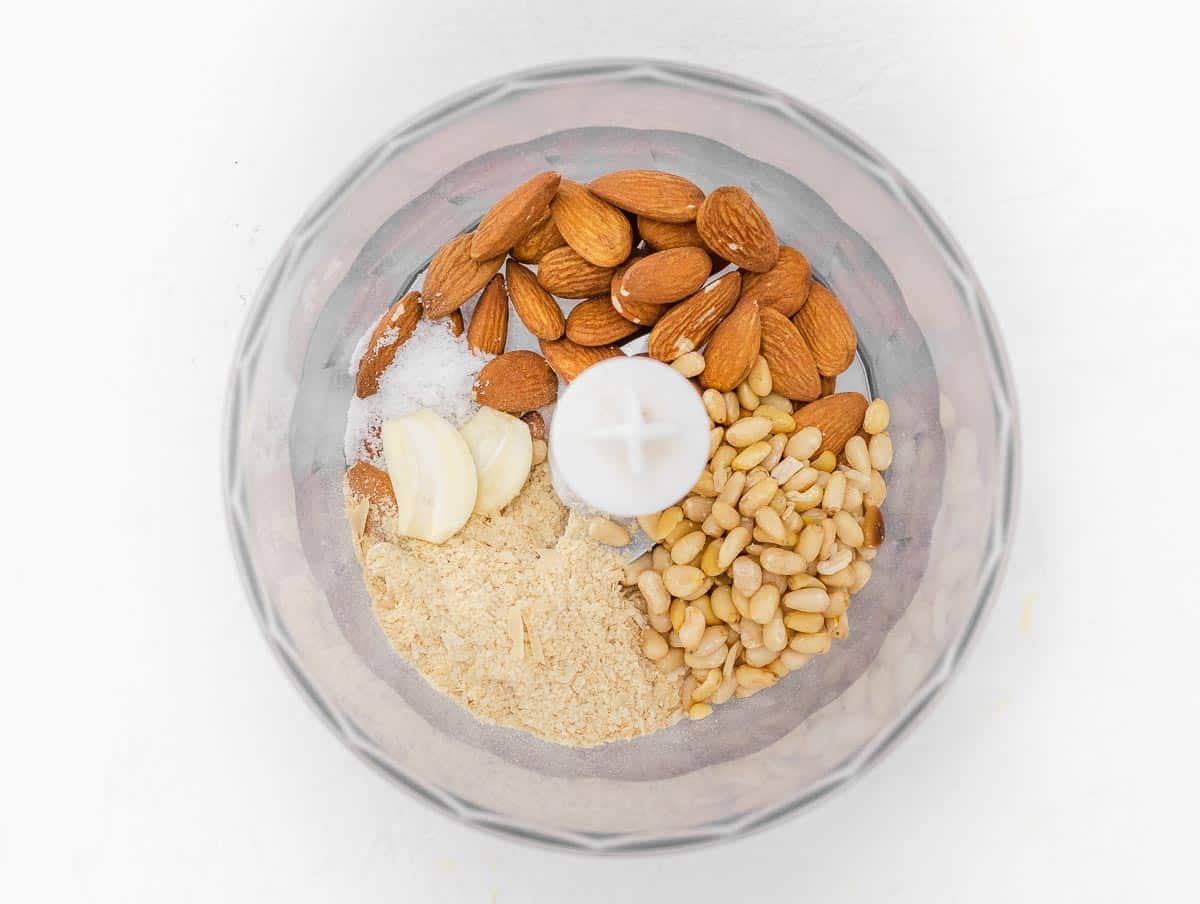
Blend for a minute until you get coarse flour.
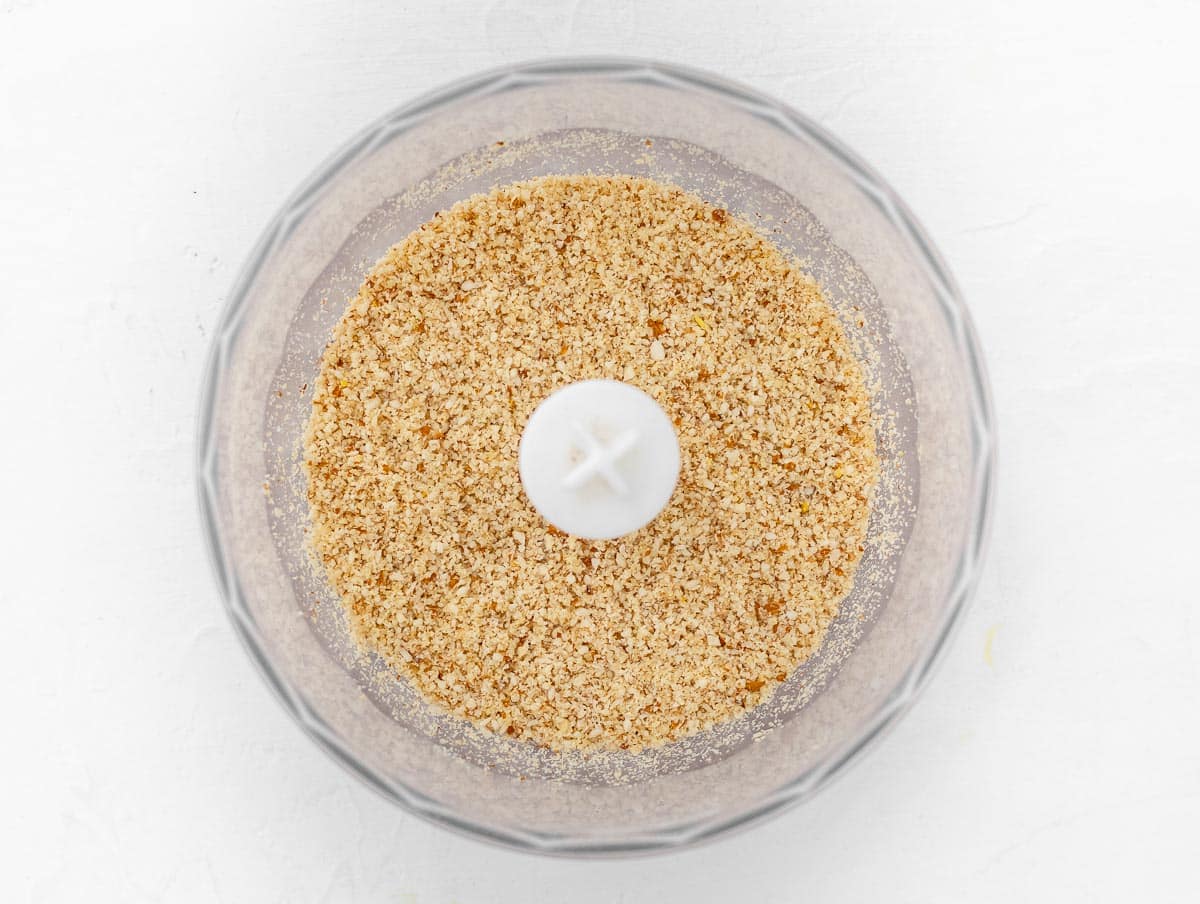
Add flat-leaf parsley, extra virgin olive oil, and ice-cold water.
Tip: rinse the parsley under running water to remove sand debris. Shake off as much water as you can.
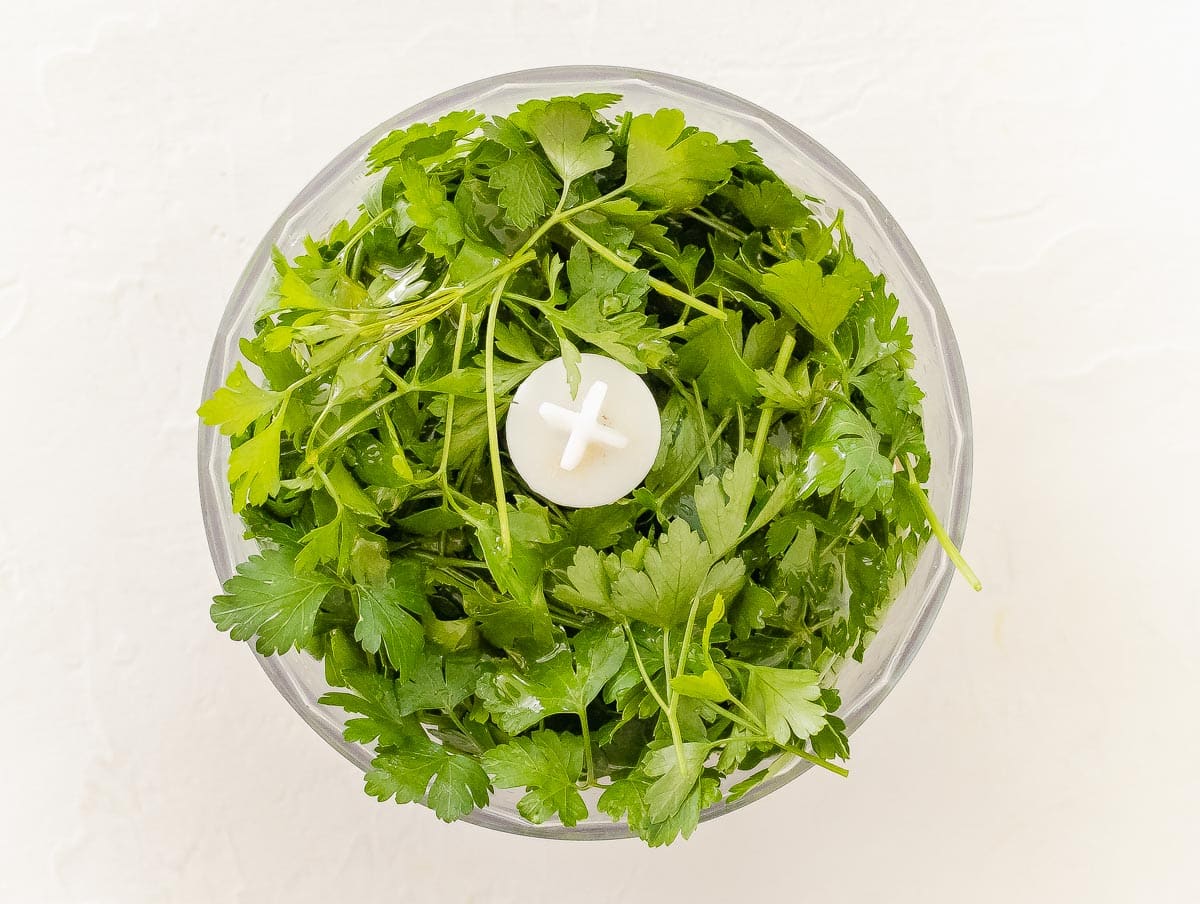
Pulse a few times until the parsley is fully combined with the other ingredients. You might need to scrape down the sides of the bowl if the food processor once or twice. Add more water if you want a thinner pesto.
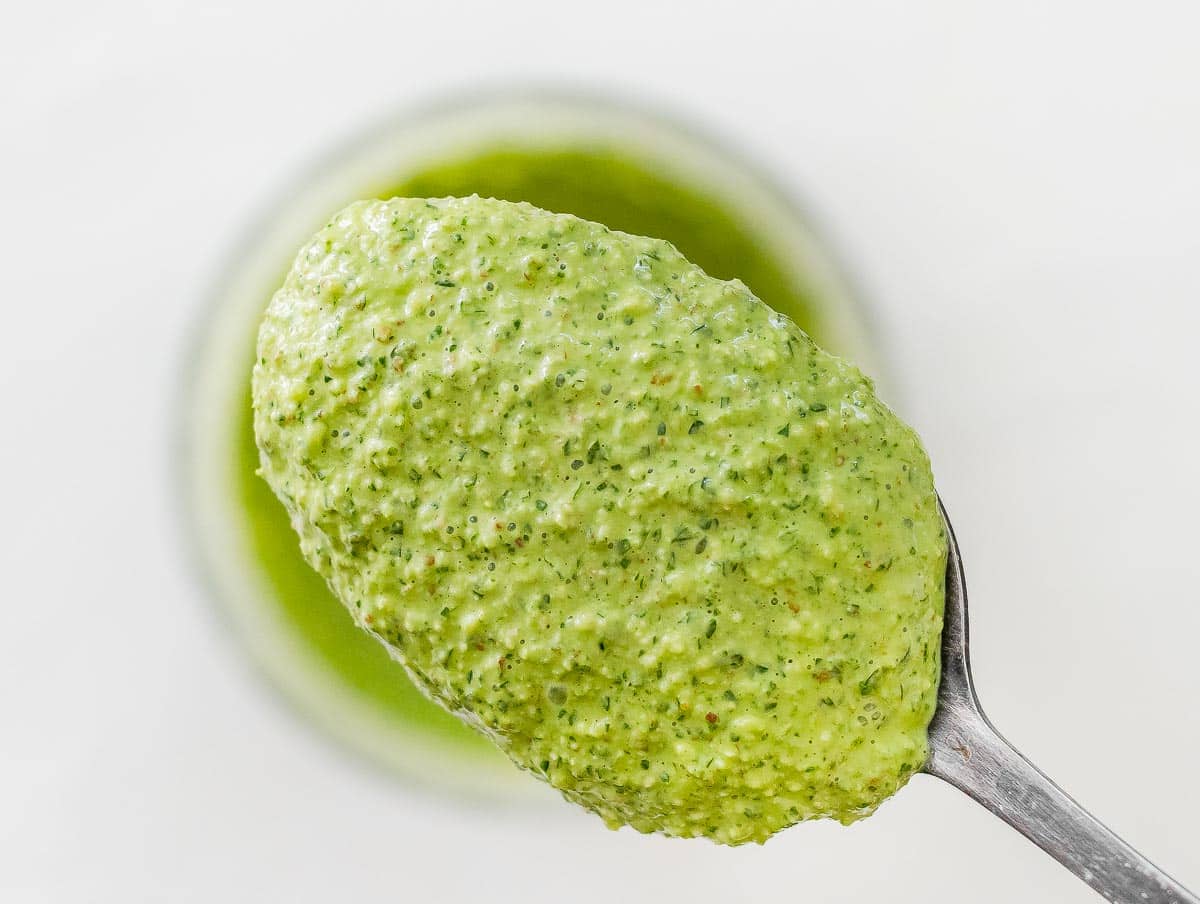
Questions
Yes, you can substitute parsley for basil in pesto. Use flat-leaf parsley, the Italian kind, for the best results. Check out our parsley pesto recipe below.
Yes, you can safely use parsley stems in pesto, as they are packed with flavour, and will make your parsley pesto even more delicious. Discard the woodier, larger ones.
More Pesto Recipes
Pesto is an easy way to dress a vegan pasta salad, make a bowl of pasta pop, and drizzle on a serving of marinated tofu. It’s also a handy way to get more veggies and healthy fats into your diet, take your pick here:
- Arugula pesto: a healthy and mild sauce that works well in potato salad and vegetable couscous salad
- Artichoke pesto: a creamy and mild condiment perfect for bow tie pasta and pasta salads
- Chestnut pesto is a luxurious winter pesto that pairs with spaghetti and roasted mushrooms. It’s cozy, scrumptious, and our favorite date-night condiment
- Sun–dried tomato pesto with healthy omega-3 fats (walnuts) is a great dip served with focaccia or flatbread
- Red pepper pesto is perfect in a sandwich as a spread. Pair with grilled eggplant and slices of grilled tofu for a complete meal
- Zucchini pesto is a light, fresh summer pesto. It’s a perfect condiment for BBQ night to drizzle on grilled veggies and mains
Storage
Store vegan parsley pesto in a jar in the refrigerator for up to 5 days. You can cover it with a thin layer of olive oil to prevent it from drying up and preserve its bright green color.
If you want to store it for longer, then freeze it. To freeze, add it to a small jar or in ice cube trays and pop it in the freezer. Use within 6 months. Thaw in the refrigerator overnight, or if using it with pasta, melt with some pasta cooking water.
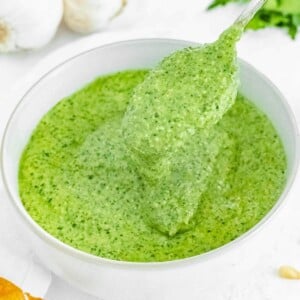
Parsley Pesto
Equipment
- Food processor or blender
Ingredients
- 1 small garlic clove
- ⅓ cup almonds
- 2 tablespoons pine nuts
- 3 tablespoons nutritional yeast
- ½ teaspoon salt
- 2 packed cups parsley
- ¼ cup cold water
- ¼ cup extra virgin olive oil
Instructions
- Peel and cut the garlic in half lengthwise, remove its core, if any, and add it to the food processor.Note: the core of the garlic can be hard to digest; we remove it to have a lighter pesto.
- Add almonds, pine nuts, nutritional yeast, and salt.
- Blend until you get a finely coarse texture (1 minute).
- Add parsley (remove thicker stems) olive oil, and ice-cold water.
- Pulse a few times until the parsley is fully incorporated with the other ingredients.Taste and adjust for salt. If you prefer a thinner pesto, add more oil or water.
- Use immediately, or store in the refrigerator in a bowl with a thin layer of olive oil on top to prevent it from drying out and losing color. Alternatively, transfer into a small jar and freeze up to 6 months.

